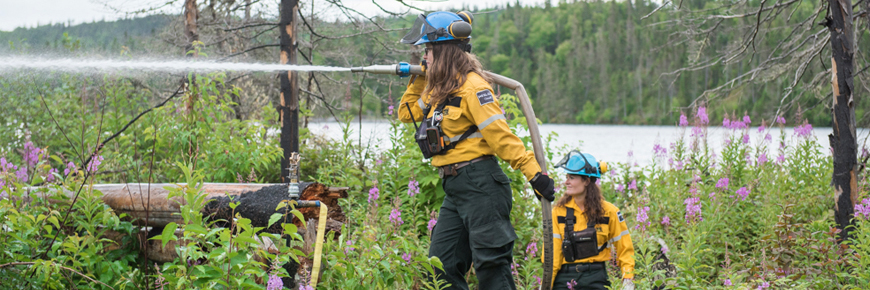
The role of fire
Pukaskwa National Park
Even though fire has been a natural and essential process of the boreal forest for over 9,000 years, it was excluded or suppressed within national parks for many decades. Recently, Parks Canada staff has restored the role of fire within the ecosystem by allowing certain wildfires to run their course as well as setting and controlling fires in key areas.
Pukaskwa National Park has been using fire as a vegetation management tool since 1998. The park's first prescribed fire was a 25-hectare white pine restoration burn. The second project was a 25-hectare mixed wood burn in 2002. Both of these projects provided valuable experiences and skills for park fire management staff to conduct larger prescribed burns in the future.
The role of fire: Effects on forest
Fires burn with variable intensity and severity across the landscape due to changes in weather, terrain, wind and other factors. Areas where the forest is completely consumed by fire are interspersed by patches of unburned and lightly burned forest. In this way fire increases the diversity of the ecosystem over time.
Some varieties of trees in the boreal forests have adapted to survive forest fires…by having fire retardant cones! Jack pine, for example, has evolved with fire by developing specialized serotinous cones (seeds that require specific environmental triggers to be released) that delay the spread of seeds only once extreme temperatures (such as those of a forest fire) are reached.
The role of fire: Effects on soil
Fire kick-starts regeneration by providing ideal growing conditions. In cool temperate areas such as Pukaskwa National Park, decay is slow and logs, leaves and needles pile up on the forest floor. Fire reduces this material to mineral-rich ash, releasing and recycling nutrients. Fire also creates openings in the forest. Sunlight penetrates these gaps, warming the soil and stimulating new growth from seeds and roots.
Occasional fires reduce the amount of accumulated fuel on the forest floor (woody debris, dead trees, forest floor litter). This reduces the potential for extremely large, hot fires, which can result in increased erosion, and loss of soil fertility.
The role of fire: Effects on wildlife
During a forest fire, animals will react instinctively, as many have never seen fire before. Animals that are able to, will flee, while others such as snakes, turtles and salamanders may simply burrow in the ground or under rocks to protect themselves. In fact, forest fires may actually help increase the abundance of certain wildlife.
In general, fire increases the abundance of shrubs and grasses that herbivores, such as moose, feed on. Fire also results in increased availability of berries that form an important part of the diet of black bears. After a fire, woodpecker populations may increase fifty times! They come to feast on the insects that colonize the newly burned trees. Even the Canada lynx benefits from fires by using mature conifers for cover and hunts in recently burned areas that support large populations of its favorite prey – the snowshoe hare.
The role of fire: Pests and disease
Without natural processes like cold winters and wildfire, insect populations can expand rapidly and have dramatic impacts on our forests. Because of the decades of fire suppression (firefighting tactics used to slow the process or extinguish fires), many of the trees in our parks are the favoured age for certain types of destructive pests such as the spruce budworm.
Prescribed fire in strategic locations can be effective in reducing the potential for large outbreaks of disease and insects by breaking up patches of suitable host trees and creating a more resilient forest mosaic (a mixture of tree species of different ages).
Related links
- Date modified :